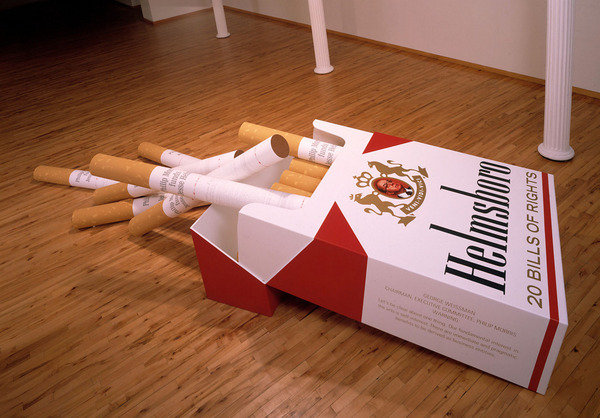Hans Haacke
dal 13/2/2012 al 22/7/2012
Segnalato da
13/2/2012
Hans Haacke
Museo Nacional Centro de Arte Reina Sofia, Madrid
Castles in the air. Often linked to institutional critique, the work of Hans Haacke dismantles the idea of the autonomy of museums and art institutions, by showing the complex and ambiguous networks of relationships involving capital and power that support not only museums but also cultural institutions. The exhibition examines the relationships between art, patronage and advertising and is made up of his most recent project, which focuses on the Spanish situation, and some of his pre-existing pieces.

Curated by Manuel Borja-Villel
Hans Haacke (1936), a German-born artist living in New York since the 1960s, is one of the pioneers and main representatives of what is known as institutional critique. In his work he looks at the different ways that political and economic institutions make use of prestige in the art sphere. The exhibition examines the relationships between art, patronage and advertising and is made up of his most recent project, which focuses on the Spanish situation, and some of his pre-existing pieces.
Often linked to institutional critique, the work of Hans Haacke dismantles the idea of the autonomy of museums and art institutions, by showing the complex and ambiguous networks of relationships involving capital and power that support not only museums but also cultural institutions. As the artist himself wrote, in an exchange with the sociologist Pierre Bourdieu, art institutions, kind of like schools, are formative places. They influence the way we see ourselves and how social relationships are considered. (…) Our values are subtly negotiated with them. It is, if you will, a battlefield where the different conceptions of the social sphere fight it out. The world of art, unlike what most people think, is not a world apart.
Wednesday 15th february - Nouvel Building, Auditorium 400
Hans Haacke, in a conversation with Walter Grasskamp
In this talk, Haacke and the art critic and historian Walter Grasskamp look at several decades of this dialectic of tension between the artist and the museums. The dialogue consists of a diachronic examination of the artist's fifty years of production, by looking at ten works commented in relation to their different institutional models and contexts.
Participants:
Walter Grasskamp is a critic, art historian and professor at the Academy of Fine Arts of Munich. He has contributed to many books and catalogues dedicated to Hans Haacke, such as Hans Haacke. “Obra social” (Fundació Antoni Tàpies, 1995), Hans Haacke (Phaidon Press, 2004) and Hans Haacke: For Real (Richter Verlag, 2007).
Hans Haacke is an artist and professor emeritus at the Cooper Union School of Art in New York. His work began in the 1960s but it retains all of its relevance today, a time in which the model of the museum and its public governance are the subject of debate.
Image: Helmsboro Country (1990), silkscreen prints and photographs on wood, cardboard and paper box: 30 1/2 x 80 x 47 1/2 in (77.5 x 203.2 x 120.7 cm); cigarettes, each: 6 1/2 x 6 1/2 x 69 1/2 in (16.5 x 16.5 x 176.5 cm). Courtesy Paula Cooper Gallery
Press conference tuesday 14th february h 12a.m.
Opening wednesday 15th february 10a.m.-9p.m.
Gabinete de Prensa tel 91 7741005 / 1006 Milena Ruiz Magaldi prensa1@museoreinasofia.es - prensa2@museoreinasofia.es
Museo Nacional Centro de Arte Reina Sofía
Sabatini Building, third floor, Zone A
Santa Isabel, 52- Madrid
Hours: Mon-sat 10-21, sun 10-14.30
Admission: 6 euro, 3 concessions



